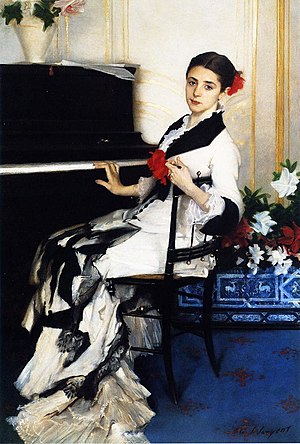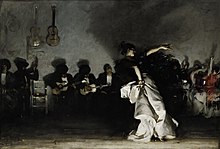Madame Ramon Subercaseaux

|
| Madame Ramon Subercaseaux |
|---|
| John Singer Sargent , 1880 |
| Oil on canvas |
| 165.1 × 109.9 cm |
| Private collection |
Madame Ramon Subercaseaux is a painting by the American painter John Singer Sargent from 1880. It is one of Sargent's early works and was commissioned shortly after the successful exhibition by Fumée d'Ambre Gris and Madame Pailleron at the Salon de Paris in 1880 .
The paintings
In the course of his life, Sargent became one of the most important portraitists of the late 19th and early 20th centuries. In 1880 the 24-year-old was still at the beginning of his career. He was aware that a successful career as a painter largely depended on getting a positive impression during the Salon de Paris. Sargent therefore made very conscious decisions about which paintings to exhibit at the Salon de Paris. The salon was the most important art exhibition in France and at the same time a major social event. He exhibited successfully for the first time at the Salon de Paris in 1877. This was followed in 1878 by his landscape oystercatcher in Cancale and in 1879 by the portrait of his teacher Carolus-Duran . In 1880, Sargent decided to exhibit Fumée d'Ambre Gris, a painting that corresponded to the current fashion of Orientalism and, with the portrait of Madame Pailleron, another painting that demonstrated his skills as a portraitist.
Sargent's hopes were confirmed. The Chilean painter Ramón Subercaseaux Vicuña became aware of Sargent through the exhibition and commissioned him to paint a painting by his wife, Amalia Errazuriz y Urmeneta, who was only 20 years old. She noted in her private notes that the main reason for the commission was Fumée d'Ambre Gris . The couple found the Sargent studio too unconventional, and Sargent portrayed Amalia Errazuriz y Urmeneta in the couple's apartment on Avenue Bois de Boulogne. According to Amalia Errazuriz y Urmeneta, Sargent carefully selected every detail and color of the portrait. Sargent drew essential inspiration from his previous short visit to Spain - among other things, he brought her music that interpreted Spanish and South American dances. In fact, the dancer's dress in El Jaleo , which was created two years later and in which Sargent explicitly processed the impressions from his stays in Spain, is reminiscent of that of the sitter and both paintings have red accents.
Amalia Errazuriz y Urmeneta notes in her notes that she and her husband were very impressed by Sargent's manners and soon regarded him as a friend. In fact, the Sargent couple met again in Venice in September and October, and Ramón Subercaseaux stated in his autobiography that Sargent would have been pleasant company and that a lot of time was spent on excursions together.
See also
literature
- Stanley Olson: John Singer Sargent - His Portrait . MacMillan, London 1986, ISBN 0-333-29167-0 .
- Deborah Davis: Strapless - John Singer Sargent and the Fall of Madame X . Jeremy P. Tarcher / Penguin, New York 2003, ISBN 1-58542-221-5 .
Web links
- Webpage of the JSS gallery (English)
Individual evidence
- ↑ Olson: John Singer Sargent ; P. 67.
- ↑ Olson: John Singer Sargent ; P. 80.
- ↑ Background information on the portrait of Madame Ramona Subercaseaux ( Memento of the original of May 7, 2007 in the Internet Archive ) Info: The archive link has been inserted automatically and has not yet been checked. Please check the original and archive link according to the instructions and then remove this notice. , accessed on August 20, 2014
- ↑ Olson: John Singer Sargent ; P. 79.
- ↑ Olson: John Singer Sargent ; P. 80.
